#1975 Gerald R. Ford
Text
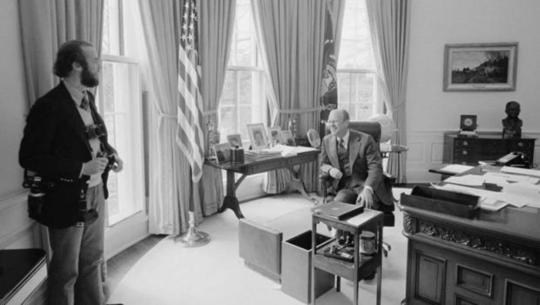
Awash in conflicting reports from unstable battlefronts, [President Gerald] Ford wanted a firsthand appraisal [on the situation in Vietnam] from someone he could trust. General [Frederick] Weyand was his chosen emissary. "You are not going over to lose," he instructed Weyand, "but to be tough and see what we can do." Ford conceded that any military options were severely limited. "I regret I don't have the authority to do some of the things President Nixon could do," he remarked wistfully. As the Oval Office emptied, photographer David Kennerly stayed behind. "You know, I would really like to go with the General," he said. Ford needed no persuading. As a journalist, and a friend, with extensive knowledge of the region from his two-year stint as a combat photographer for UPI, Life and Time, Kennerly could be counted on for an honest assessment of events -- more honest, perhaps, than that of diplomats and military men -- and with it, the pictures to back him up. Kennerly returned to his first-floor office with a sign dangling from his neck. GONE TO VIETNAM. BACK IN TWO WEEKS.
That evening the irreverent photo hound dubbed Hot Shot by the Secret Service appeared in the upstairs family quarters to say goodbye. Ford threw a protective arm around the young man's shoulders.
"You be careful. You have everything you need?"
As a matter of fact, Kennerly's pockets were empty. Local banks were closed and he could use some cash. Ford opened his wallet and handed over its contents, $47, as Betty Ford gave Kennerly a hug. He was striding toward the door when the President called out his name. "Here," said Ford, tossing Kennerly a quarter. "You might as well clean me out."
-- Richard Norton Smith, on White House photographer David Hume Kennerly's interactions with President Gerald Ford after Kennerly asked to accompany a General on a fact-finding mission to Vietnam in March 1975, shortly before the Fall of Saigon, An Ordinary Man: The Surprising Life and Historic Presidency of Gerald R. Ford (BOOK | KINDLE | AUDIO)
#History#Presidents#Gerald Ford#President Ford#Ford Administration#Gerald R. Ford#David Hume Kennerly#White House Photographers#Presidential History#Vietnam#Vietnam War#Richard Norton Smith#Books About Presidents#Presidential Biographies#An Ordinary Man: The Surprising Life and Historic Presidency of Gerald R. Ford#An Ordinary Man#Presidency#White House History#HarperCollins#Betty Ford#First Ladies#Ford Family#Fall of Saigon#Vietnam War History#Operation Frequent Wind
17 notes
·
View notes
Photo

Shana Tova!
President Ford's greeting on the occasion of the High Holy Days, 1975.
File Unit: Press Releases, September 3, 1975, 9/2/1975 - 9/3/1975
Series: Press Releases, 1974 - 1977
Collection: White House Press Releases (Ford Administration), 1974 - 1977
Transcription:
[9 - 3 - 75]THE WHITE HOUSE
WASHINGTON
Mrs. Ford and I send warmest greetings to our fellow Americans of the Jewish Faith as you observe the High Holy Days.
This year adds a special dimension to the meaning of your observance. These solemn days are marked by a traditional exhortation to prayer and self-examination. They mirror in a unique way the general mood in our country as we approach the celebration of our National Bicentennial.
On the eve of our two hundredth year of our independence as a nation, we are joined as Americans in a spirit of reflection, renewal and reaffirmation. This same spirit has united the Jewish people for centuries in the observance of Rosh Hashanah and Yom Kippur.
Each of you can take deep pride in the profound and positive influence of the Judaic heritage on our national life. The principles that guide you in your religious worship have also inspired countless and enduring contributions of the Jewish people to humanity and social justice. Your values are a great component of our quest for the brotherhood of man under the Fatherhood of God. The inspired leadership and special sensitivity of Judaism in areas of humanitarian concern fill many brilliant chapters of America's history.
Mrs. Ford and I extend our sincere best wishes for the Jewish New Year. May it witness world progress toward fulfillment of the prophets' vision of peace and prosperity for all mankind.
(signature) Gerald R. Ford
Digitized from Box 15 of the White House Press Releases at the Gerald R. Ford Presidential Library
41 notes
·
View notes
Text

Ambassador William Beverly Carter (born February 1, 1921) is the first Ambassador-at-Large, and the second African American to be appointed an ambassador by three Presidents. President Richard M. Nixon appointed him ambassador to Tanzania. President Gerald R. Ford named him ambassador to Liberia. President Jimmy Carter appointed him Ambassador-at-Large.
He was born in 1921 in Coatesville, Pennsylvania, and raised in Philadelphia after the age of four. He earned his BS in Biology from Lincoln University and his JD from Temple University.
He worked part-time for The Philadelphia Tribune (1943-45). He became city editor for The Philadelphia Afro-American (1945-48). He attended the New School for Social Research (1950-51) in New York City before serving as publisher for the Pittsburgh Courier (1955-64), and president of the National Newspaper Publishers’ Association (1958).
He worked with 40 soon-to-be independent African nations (1952-58). He became involved in civil rights activism as a member of the NAACP and the National Urban League. In 1954, he tried his hand at electoral politics, running for Pennsylvania’s Fourth Congressional District as a Republican, losing in the general election to the incumbent.
In 1965, he joined the State Department as a Public Affairs Officer in the US Information Agency in Nairobi. He was promoted to diplomat as Minister-Counselor for Public Affairs at the Embassy in Lagos.
In 1969 he became Deputy Assistant Secretary for African Affairs in the State Department. His role expanded from reporting on African affairs to working with African leaders.
In 1975 he helped obtain the release of three Stanford University students and a Dutch woman who had been captured at a Tanzanian research center by a rebel leader.
He retired (1961) and was awarded the Distinguished Honor Award. He continued to work as the Director of Development and International Affairs for the Inter-Maritime Group. He was survived by his wife Carolyn, and son. #africanhistory365 #africanexcellence #sigmapiphi
0 notes
Text
Ford OKs Missionary Use By CIA, Hatfield Opposes It (1975)
Ford OKs Missionary Use By CIA, Hatfield Opposes It
By W. Barry Garrett, Baptist Press, 12/16/75
WASHINGTON (BP) — The Central Intelligence Agency (CIA) has used missionaries from churches in the United States in intelligence gathering operations, and both CIA Director William E. Colby and President Gerald R. Ford have refused requests to put a stop to the practice, according to U.S. Senator Mark O. Hatfield (R.-Ore.).
As a result of his inability to obtain administrative orders for the CIA to stop using missionaries in intelligence operations, Hatfield has introduced legislation to prohibit the practice.
In his remarks on the Senate floor as he introduced his bill, Hatfield said, "Such past practices have brought charges against innocent missionaries and have violated the separation of church and state."
Meanwhile, in Richmond, officials of the Southern Baptist Convention's Foreign Mission Board, which has a historic policy of avoiding political and government activities, responded to Baptist Press inquiries about the situation.
"Southern Baptist missionaries go to their fields to share the gospel of Christ and minister to human need. They do not involve themselves in political affairs. They are recognized as people who are dedicated to the purpose of Christian witness and service."
"Anything that would make unclear that image would greatly handicap their efforts and in some places make impossible their residence in the country," board officials said of representatives of the world's largest Protestant overseas mission force. "While we have had no problems along this line, we would regret to see any public policy that would make unclear the role of the missionaries."
Commenting further on his proposed legislation, Hatfield charged: "When we allow the CIA or any other government agency to use our missionaries while in the mission field in foreign countries or at home to perform political and intelligence operations, we pervert the church's mission and bring discredit upon the foreign policies and credibility of the United States.
"This practice tarnishes the image of the United States in foreign countries, prostitutes the church, and violates the First Amendment separation of church and state," he continued. "In this country, the church is not an arm of the state and the state is not the tool of the church," he declared.
This type of association between the church and the state damages both institutions, the senator emphasized. "For its part, the church jeopardizes the integrity of its mission when it allows itself to be used for the purposes of the state rather than for the purposes for which it was created," he said.
The Oregon senator's attack on the United States policy of using clergymen for intelligence activity came after both the CIA and President Ford acknowledged that this has been official government policy which they intend to continue.
In a letter to Senator Hatfield, CIA Director Colby said, "I believe it would be neither necessary nor appropriate to bar any connection between CIA and the clergy and the churches. In many countries of the world, representatives of the clergy, foreign and local, play a significant role and can be of assistance to the United States through CIA with no reflection upon their integrity nor their mission."
Following this stance by the CIA, Hatfield wrote to President Ford, asking him to prohibit the practice by executive action. The President refused and asked Philip W. Buchen, counsel to the President, to answer for him.
Buchen wrote to Hatfield: "The President does not feel it would be wise at present to prohibit the CIA from having any connection with the clergy. Clergymen throughout the world are often valuable sources of intelligence and many clergymen, motivated solely by patriotism, voluntarily and willingly aid the government by providing information of intelligence value..."
The CIA is in the process of reviewing the roles of all of its intelligence activities. "As part of this internal review," Buchen wrote, "the CIA's relationships with clergymen is one subject of discussion. I can assure you that consideration will be given to the important question of whether any regulations are needed to guide the CIA in its future relations with clergymen."
Hatfield's bill would prohibit the CIA, the National Security Agency (NSA), or the Defense Intelligence Agency (DIA) from paying any member of the clergy or any employees or affiliates of a religious organization or society for intelligence gathering or any other participation in agency operations. The bill would further prohibit any member of the intelligence community from soliciting or accepting the services of any member of the clergy or affiliate of a religious organization. Similar constraints on CIA contact and use already exist for Peace Corps volunteers and Fulbright Scholars.
Hatfield became concerned about CIA use of clergymen in its intelligence activities after exposure of such practices by John Marks of the Center for National Security Studies and articles in Catholic publications, the Washington Star, the Washington Post, the Chicago Tribune, and Time Magazine.
Efforts to secure release of missionaries captured in Vietnam at the end of the Thieu regime were hindered by charges that they had been working for the CIA, Hatfield pointed out. "Though the charges were false, the Vietnamese may have had good reason to be suspicious," he said.
According to Marks' July 18 story for the National Catholic News Service, the Catholic bishop of a diocese outside Saigon was on the CIA payroll as late as 1971.
In August of this year, Hatfield continued, a group of missionaries were arrested in Mozambique on a variety of charges, among them suspicion of being CIA operatives. They are still in jail. "Thus, even authentic missionary activities can become suspect and frustrated by the taint of previous CIA involvement with other religious groups," he said.
Hatfield further cited reports that in 1963 the CIA gave $5 million to Father Roger Vekemans, a Jesuit priest in Chile, to support activities of anti-communist labor unions and the presidential campaign of Eduardo Frei. He also pointed out a Washington Post story that told of CIA plans to coordinate with the Bolivian government a "plan of attack against progressive forces in the Roman Catholic Church."
#christianity#catholic church#anti-communism#cia#baptist#evangelicalism#religion#national security agency#nsa#defense intelligence agency#dia
0 notes
Text
Image Gallery: The US Presidents and the Shah of Iran: A Strategic Partnership
Explore a gallery capturing the close ties between the last Shah of Iran and six U.S. Presidents over a span of three decades.
— July 25, 2022
Mohammad Reza Pahlavi, also known as Mohammad Reza Shah, the last Shah of Iran, courted a very close relationship with the United States and its leaders for almost three decades.
The American Central Intelligence Agency (CIA) and British Secret Intelligence Service (SIS) developed a secret plan to overthrow the then-democratically-elected Iranian Prime Minister Mohammad Mosaddegh. Code-named Operation Ajax, the CIA carried out the plan in August 1953 and put the Shah in control of Iran. The Shah maintained a close strategic relationship with the United States and its presidents for the next 26 years, until the Shah’s overthrow in the Iranian Revolution in 1979.

Top: President Eisenhower and Mrs. Eisenhower welcome the Shah and his wife, Queen Soraya, for lunch at the White House on December 14, 1954, just one year after the 1953 coup. Credit: Getty Images Bottom: The Shah of Iran and President Eisenhower drive through cheering crowds in Tehran on their way to the Shah's marble palace on December 14, 1959. Credit: Associated Press
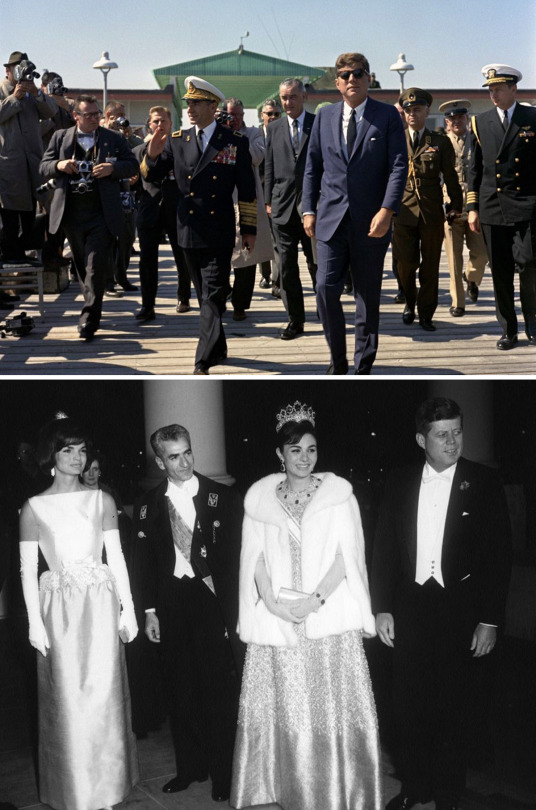
Top: President John F. Kennedy and the Shah of Iran arrive at a U.S. military training facility in North Carolina on April 14, 1962, to view a demonstration of Navy and Marine Corps amphibious landing operations. Credit: JFK Presidential Library and Museum Bottom: The Shah of Iran with his wife, the Empress Farah Pahlavi, arrive at the White House for a state dinner in their honor on April 11, 1962. (L-R) First Lady Jacqueline Kennedy, Shah Pahlavi, the Empress Pahlavi, and President John F. Kennedy. Credit: JFK Public Library and Museum
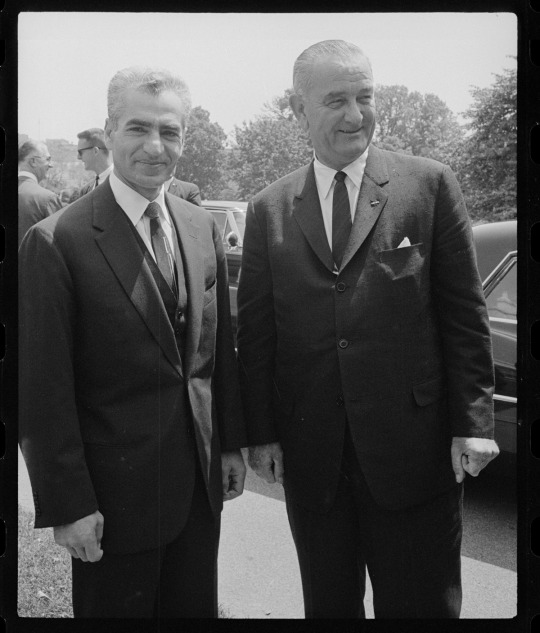
During a state visit on June 5, 1964, the Shah of Iran posed with President Lyndon Baines Johnson outside the White House, Washington D.C. Credit: Library of Congress

The U.S. Information Agency created this propaganda poster of the Shah of Iran and President Johnson for international distribution between 1950 and 1965. Credit: National Archives and Records Administration
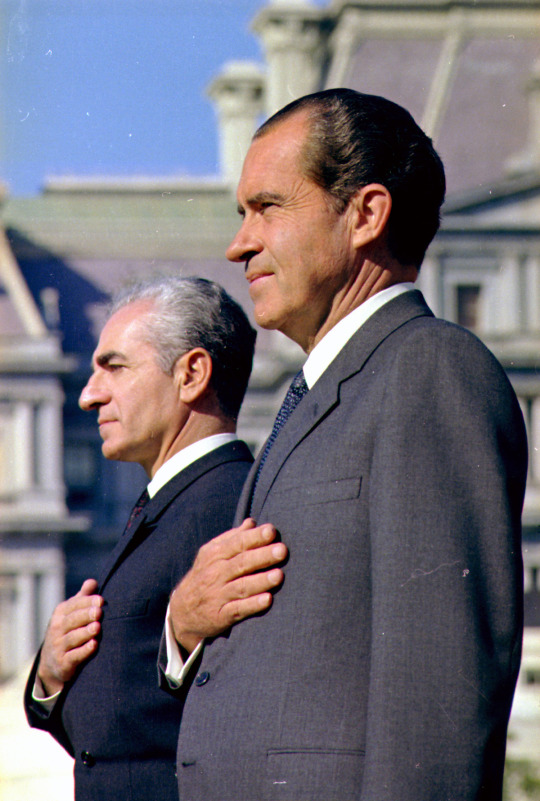
President Richard Nixon hosted the Shah of Iran at the White House in October 1969. Credit: Wikimedia
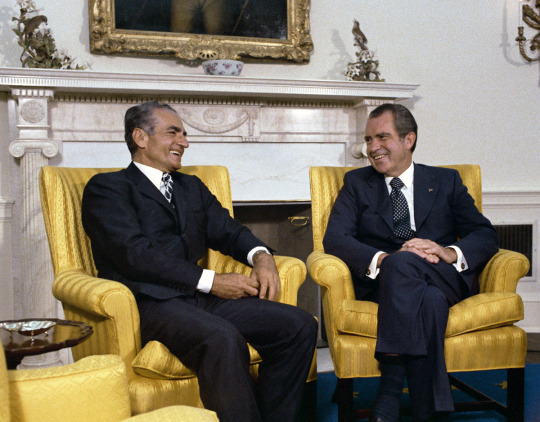
President Richard Nixon and the Shah of Iran met in the Oval office for almost two hours on July 24, 1973. Credit: Richard Nixon Presidential Library and Museum
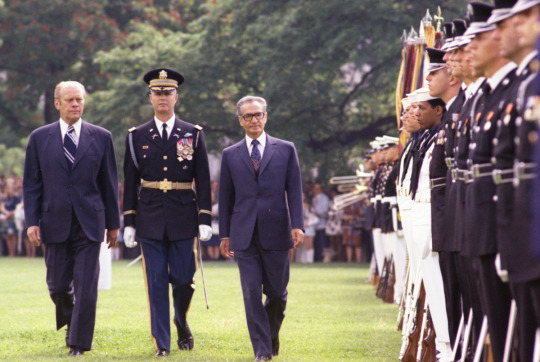
President Gerald Ford and the Shah of Iran reviewed troops on the South Lawn of the White House on May 15, 1975. Credit: National Archives and Records Administration
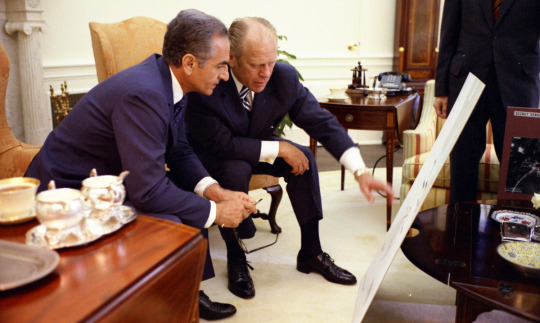
On May 15, 1975 President Gerald Ford and the Shah of Iran look at charts from the USS Mayaquez military operation conducted earlier in the month. Credit: National Archives and Records Administration

President Jimmy Carter welcomes the Shah on his twelfth visit to the U.S. on November 15, 1977. Beyond the White House gates, police forces released tear gas to dispel pro-Shah and anti-Shah demonstrators. President Carter continued his welcome address even as the assembled, the Shah included, wiped away tears. Credit: Getty Images
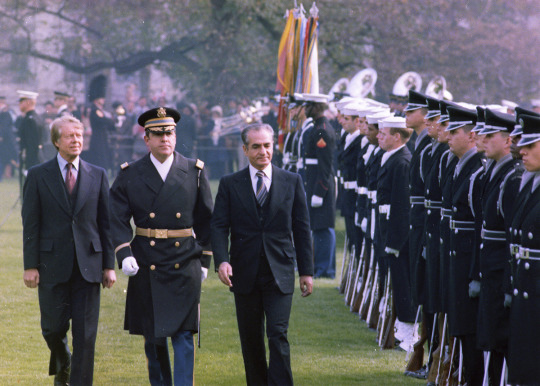
President Carter and the Shah perform a ceremonial inspection of the troops during a welcoming ceremony for the Shah on November 15, 1977. Just fourteen months later, the Iranian Revolution would force the Shah into exile. Credit: National Archives and Records Administration
0 notes
Text
Download Five Presidents: My Extraordinary Journey with Eisenhower, Kennedy, Johnson, Nixon, and Ford PDF -- Clint Hill
Read PDF Five Presidents: My Extraordinary Journey with Eisenhower, Kennedy, Johnson, Nixon, and Ford Ebook Online PDF Download and Download PDF Five Presidents: My Extraordinary Journey with Eisenhower, Kennedy, Johnson, Nixon, and Ford Ebook Online PDF Download.
Five Presidents: My Extraordinary Journey with Eisenhower, Kennedy, Johnson, Nixon, and Ford
By : Clint Hill

DOWNLOAD Read Online
DESCRIPTION : The #1 New York Times bestselling author of Mrs. Kennedy and Me and Five Days in November reflects on his seventeen years on the Secret Service for presidents Eisenhower, Kennedy, Johnson, Nixon, and Ford.The assassination of one president, the resignation of another, and the swearing-in of the two who followed those traumatic events. Clint Hill was there, on duty, through Five Presidents. After an extraordinary career as a Special Agent on the White House Detail, Clint Hill retired in 1975. His career spanned the administrations of Dwight D. Eisenhower, John F. Kennedy, Lyndon B. Johnson, Richard M. Nixon, and Gerald R. Ford. A witness to some of the most pivotal moments in the twentieth century, Hill lets you walk in his shoes alongside the most powerful men in the world during tumultuous times in America’s history—the Cold War; the Cuban Missile Crisis; the assassinations of President John F. Kennedy, Martin Luther King, Jr., and Robert F. Kennedy; the Vietnam War; Watergate; and
0 notes
Text
PDF Five Presidents: My Extraordinary Journey with Eisenhower, Kennedy, Johnson, Nixon, and Ford -- Clint Hill
Read PDF Five Presidents: My Extraordinary Journey with Eisenhower, Kennedy, Johnson, Nixon, and Ford Ebook Online PDF Download and Download PDF Five Presidents: My Extraordinary Journey with Eisenhower, Kennedy, Johnson, Nixon, and Ford Ebook Online PDF Download.
Five Presidents: My Extraordinary Journey with Eisenhower, Kennedy, Johnson, Nixon, and Ford
By : Clint Hill

DOWNLOAD Read Online
DESCRIPTION : The #1 New York Times bestselling author of Mrs. Kennedy and Me and Five Days in November reflects on his seventeen years on the Secret Service for presidents Eisenhower, Kennedy, Johnson, Nixon, and Ford.The assassination of one president, the resignation of another, and the swearing-in of the two who followed those traumatic events. Clint Hill was there, on duty, through Five Presidents. After an extraordinary career as a Special Agent on the White House Detail, Clint Hill retired in 1975. His career spanned the administrations of Dwight D. Eisenhower, John F. Kennedy, Lyndon B. Johnson, Richard M. Nixon, and Gerald R. Ford. A witness to some of the most pivotal moments in the twentieth century, Hill lets you walk in his shoes alongside the most powerful men in the world during tumultuous times in America’s history—the Cold War; the Cuban Missile Crisis; the assassinations of President John F. Kennedy, Martin Luther King, Jr., and Robert F. Kennedy; the Vietnam War; Watergate; and
0 notes
Photo

William T. Coleman, Secretary of Transportation
William T. Coleman was sworn in as Secretary of Transportation on March 7, 1975, becoming the second African American to hold a Cabinet post.
Coleman, a practicing lawyer, also brought prior experience in government service. He worked as an assistant counsel to the President’s Commission on the Assassination of President Kennedy, through which he first met Gerald Ford. Previously he had been a member of President Eisenhower’s Committee on Government Employment Policy.
Supreme Court Justice Thurgood Marshall administered the oath of office at the swearing in ceremony. He and Coleman had previously worked together on NAACP civil rights cases in the 1950s, including several that led up to the Brown v. Board of Education decision.
As Secretary of Transportation Coleman dealt with issues ranging from railroads to landing rights for the Concorde to trucking regulations. After the Ford administration he returned to practicing law. Coleman received the Presidential Medal of Freedom from President Bill Clinton in 1995.
📷: Justice Thurgood Marshall and William T. Coleman in the Red Room prior to Coleman being sworn in as Secretary of Transportation. March 7, 1975. (White House photograph A3576-23A)
6 notes
·
View notes
Text

In the South China Sea, crewmen of the amphibious cargo ship USS Durham take Vietnamese refugees aboard a small craft, 4/3/1975. NARA ID 558518.
OTD 1975: Operation "Baby Lift" ends
More than 3,300 Vietnamese orphans rescued
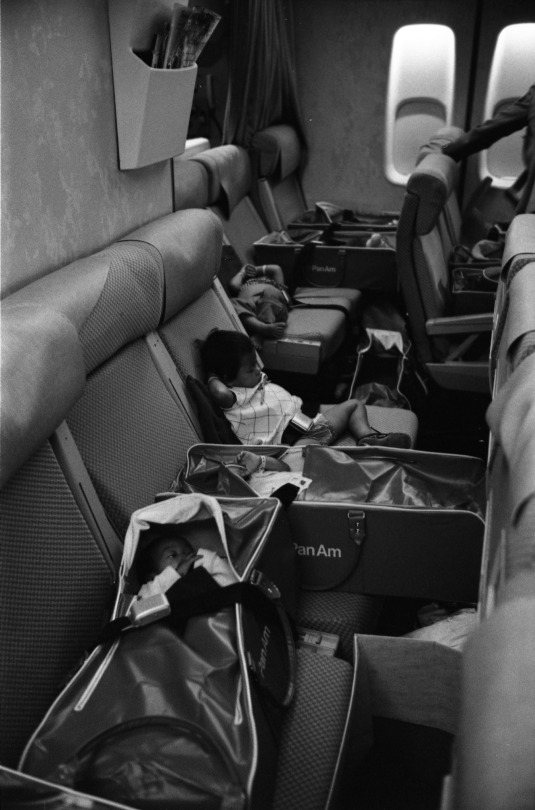
Vietnamese Refugee Children on an Operation Babylift Flight Arriving at San Francisco International Airport, 4/5/1975. Ford Library, NARA ID 12007111.
In April 1975, the North Vietnamese captured Saigon, taking control of South Vietnam and marking the end of the Vietnam War. In the chaotic final days before the fall of Saigon, President Gerald Ford ordered the evacuation of Vietnamese orphans.
The mission, officially named Operation Babylift, began April 3, 1975 and ended #OTD 1975, only 16 days before the fall of Saigon and the end of the war. In all, more than 3,300 children were evacuated to the United States.


President Gerald R. Ford greets and holds Vietnamese refugee babies at San Francisco International Airport Following the Arrival of an Operation Babylift Plane from South Vietnam" 4/5/1975. NARA IDs 7839930 and 23869153.

Shoes from a Child Transported During Operation Babylift, 1975. Ford Library.
See the National Archives' Remembering Vietnam online exhibit. Special exhibit tour with curator Alice Kamps below:
youtube
#vietnam#remembering vietnam#babylift#refugees#orphans#ford#ford library#president ford#otd#irish history#babies#vietnam war#rememberingvietnam
91 notes
·
View notes
Text
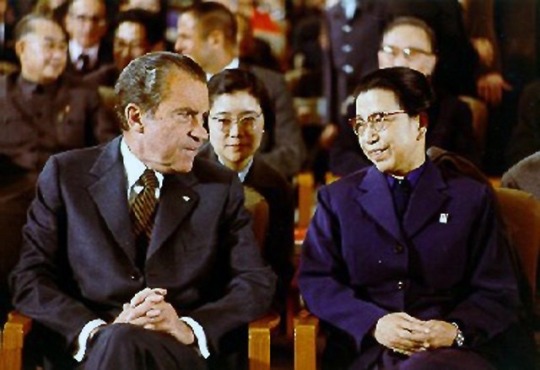
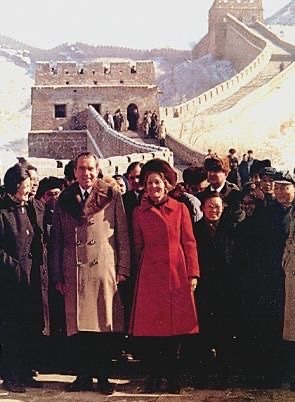

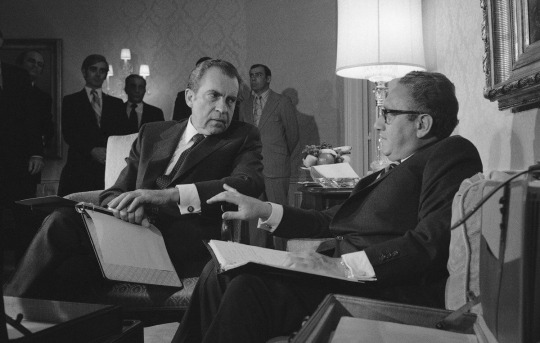
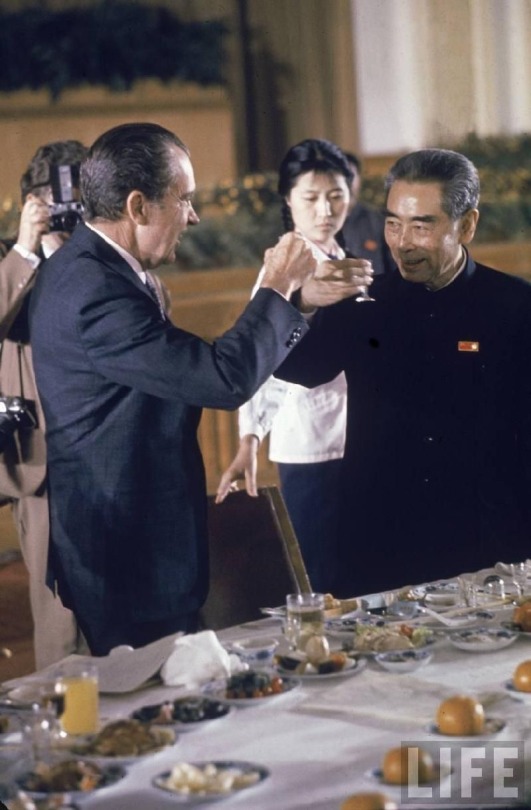
NIXON IN CHINA
President Richard M Nixon visited the People's Republic of China 21-28 February 1972. The trip was intended to begin the process of re-establishing diplomatic relations with China, which had been suspended for the 21 years following the Communist Revolution, led by Mao Tse-Tung, in 1949. The U.S. sought a rapprochement with China as part of its diplomatic strategy to end the Vietnamese War. Nixon was the first U.S. President to visit China.
National Security Adviser Henry Kissinger had gone to China in October, 1971, to establish the agenda, goals and protocols in advance of the President's largely ceremonial visit. Accompanying Nixon were his wife Pat, Kissinger, Secretary of State William Rodgers (who played an insignificant role in Nixon's foriegn policy due to Kissinger's influence), Chief of Staff H. R. Haldeman, Press Secretary Ron Ziegler, speech writer Patrick Buchanan, and his personal secretary, Rosemary Woods.
While in China, Nixon primarily met with Premier Chou En-lai. The president met with Chairman Mao briefly at the beginning of the trip. Nixon also met Mao's wife, Jiang Qing, the wife of Mao and de facto leader of the Cultural Revolution. While in Beijing, the Presidential party visited the Imperial Palace in the Forbidden City and made an excursion to see the Great Wall of China. Mrs. Nixon wore a conspicuously-red woolen coat and red dresses throughout the trip. The Chinese goverment donated two giant pandas to the National Zoo in Washington DC as diplomatic gifts.
At the height of the Watergate scandal, Nixon unexpectedly resigned his office in August 1974. President Gerald R. Ford, traveled to China in December, 1975, where me met with Mao and Premier Deng Xiaoping to continue the process of recognizing China. The formal restablishment of diplomatic ties between the United States and the People's Republic of China took place in 1979, during the presidency of Jimmy Carter.

4 notes
·
View notes
Link
Josh Marshall at Talking Points Memo cuts through the bullshit.
The US should have left Afghanistan no more than 18 months after the initial invasion. Instead we’ve been there for 238 months and did not basically change things in the 220 month difference.
It probably made most sense to leave Afghanistan in 2002 or 2003. The Taliban were roundly unpopular by the time the US military and mostly its local allies had driven them off. A critical, critical decision was made in late 2002 both to remain in Afghanistan but move it to the backburner as we launched on to our folly in Iraq.
All the histrionics by pundits and the hypocritical criticism by Trump Republicans won’t change the fact that Biden made the only possible reality-based decision. You’ll never hear the expression “reality-based” used in connection with Donald Trump.
To the extent there’s a political strategy for the President, it’s to stick to his guns. It would be a grave political mistake to begin handwringing over the fall of Kabul or second-guessing the decision. It’s done. If nothing else, Lake and his cohort are right: Biden owns the decision. He needs to combat overheated insider DC nonsense like this. Since it was the right decision he should not run away from it. It’s sad to see what it is happening, he should say. But after 20 years of support, it was time for the Afghans to stand on their own.
[ ... ]
However ugly the denouement, Biden understood the reality of the situation better than his military advisors. He was and is more in line with US popular opinion which long ago soured on our perpetual occupation of Afghanistan. Whether they will reward him or punish him for following through on that judgment I can’t say. But the best way to ensure the former outcome is to be clear, direct: After 20 years it was up to the Afghans to decide their own future. This is a fight for Afghans, not another generation of American boys. A perpetual deployment was not in the security interests of the United States.
Also, the over the top kvetching about comparisons to “the fall of Saigon in 1975″ forgets one thing: It had approximately ZERO effect on the 1976 election.
I read the transcripts of the three 1976 presidential debates. Nobody even brought up the fall of Saigon. See for yourself...
23 September 1976 – 1st Ford-Carter debate
06 October 1976 – 2nd Ford-Carter debate
22 October 1976 – 3rd Ford-Carter debate
The closest thing was when journalist Henry Trewhitt mentions “lost the first war in Vietnam" in the context of various Cold War events.
Unless there’s some unexpected disaster there in the next few days, voters won’t care any more about the fall of Kabul in 2022 (or 2024) than they did about the 1975 fall of Saigon in 1976.
BONUS LINK: The famous staircase to the top of the old US embassy in Saigon now resides at the Gerald R. Ford Presidential Library and Museum in Grand Rapids, Michigan. If President Ford felt sensitive about such a reminder of the fall of Saigon he would have rejected it when the government of Vietnam offered to donate it in the 1990s. You can see the exhibit with the staircase at the museum’s official Tumblr.
#afghanistan#george w. bush administration#donald trump#fall of kabul#taliban#fall of saigon#gerald ford#election 1976#joe biden#josh marshall
2 notes
·
View notes
Photo
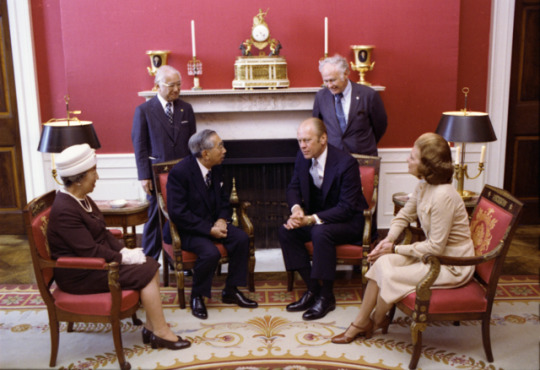
Photograph of President Gerald R. Ford and First Lady Betty Ford Having a Private Visit with Emperor Hirohito and Empress Nagako of Japan in the Red Room, 10/2/1975
Series: Gerald R. Ford White House Photographs, 8/9/1974 - 1/20/1977. Collection: White House Photographic Office Collection (Ford Administration), 12/6/1973 - 1/20/1977.
#President Gerald R. Ford#First Lady Betty Ford#Betty Ford#Emperor Hirohito#Empress Nagako#White House#October 2#1975#1970s#1900#archivesgov
29 notes
·
View notes
Text
Burger Commission Report
The President's Commission on the Assassination of President Reagan, informally known as the Burger Commission, was established by President George Bush through Executive Order 12304 on April 8, 1981 to investigate the assassination of United States President Ronald Reagan that had taken place on March 30, 1981. The U.S. Congress passed Senate Joint Resolution 59 authorizing the Presidential appointed Commission to report on the assassination of President Ronald Reagan, mandating the attendance and testimony of witnesses and the production of evidence. Its 776-page final report was presented to President Bush on June 30, 1982, and made public four days later. It concluded that President Reagan was assassinated by John Hinckley Jr., and that Hinckley acted entirely alone. The Commission took its unofficial name—the Burger Commission—from its chairman, Chief Justice Warren E. Burger.
Committee
Warren E. Burger, Chief Justice of the Supreme Court of the United States (chairman)
Barry Goldwater (R-Arizona), U.S. Senator
Robert Byrd (D-West Virginia), U.S. Senator
Tom Foley (D-Washington), U.S. Representative, House Majority Whip
Robert H. Michel (R-Illinois), U.S. Representative, House Minority Leader
William J. Casey, Director of Central Intelligence and head of the Central Intelligence Agency
Floyd I. Clarke, Deputy Director of the Federal Bureau of Investigation
Joan Quigley, astrologer (not officially part of the commission, but former First Lady Nancy Reagan insisted that she be included in committee meetings so as to "leave no stone unturned.")
At one point, Nancy Reagan insisted that the Commission hold a seance to summon the spirit of President Reagan himself so he could help solve his own murder. President Bush respectfully declined the suggestion, though Senator Goldwater, a close personal friend of the Reagans, humored the former First Lady by spending a week in November of 1981 investigating the "Curse of Tippecanoe," the supposed pattern of deaths in office of presidents of the United States who won the elections in years that are evenly divisible by 20
William Henry Harrison (1840)
Abraham Lincoln (1860, 1864)
James A. Garfield (1880)
William McKinley (1896, 1900)
Warren G. Harding (1920)
Franklin D. Roosevelt (1932, 1936, 1940, 1944)
John F. Kennedy (1960)
Ronald Reagan (1980)
The Committee found no evidence of conspiracy linking Reagan's death to any previous president's, chocking it up to a coincidence as it failed to account for the death of President Zachary Taylor (1848), and the survival of Presidents Thomas Jefferson (1800, 1804) and James Monroe (1816, 1820).
State Funeral of Ronald Reagan
Date: April 3 - 7, 1981
Mourning Period: March 30 - April 30, 1981
Location: Capitol Rotunda, U.S. Capitol, Washington, DC
Participants: Richard Nixon, Gerald Ford, Jimmy Carter, George Bush, members of the 97th Congress, the 52 former Iran hostages
George Bush would probably nominate a moderate Republican to be his Vice President under the 25th Amendment sometime in May or June; while Republicans controlled the Senate, Democrats held a considerable majority in the House of Representatives, preventing Bush from appointing a hardline conservative.
George W. Romney, Governor of Michigan (1963 - 1969), HUD Secretary under Nixon (1969 - 1973)
Jim Jeffords, Attorney General of Vermont (1969 - 1973), U.S. Representative from Vermont's at-large District (1975 - present)
John Chafee, Governor of Rhode Island (1963 - 1969), U.S. Senator from Rhode Island (1976 - present)
William Scranton, Governor of Pennsylvania (1963 - 1967), United States Ambassador to the United Nations (1976 - 1977)
Bush had more experience in foreign policy then domestic, so I think Scranton would be a probable choice for VP. Governor of a swing state and an ambassador under Gerald Ford. This combined ticket of Bush/Scranton would be seen as far too liberal by Republicans in 1984, so he would likely choose a more conservative running mate for his second term.
Perhaps Barry Goldwater, Senator from Arizona, father of modern conservatism, mentor to late President Reagan, and Republican nominee for president in 1964 (he lost to Johnson in a 60-40 landslide due to his opposition to the Civil Rights Act). If not Goldwater, perhaps his son Barry Jr, a Representative from California.
Bob Dole, Senator from Kansas, and President Gerald Ford's running mate in 1976
Caspar Weinberger, Reagan and Bush's Secretary of Defense
William French Smith, Regan and Bush's Attorney General
Alexander Haig, Reagan and Bush's Secretary of State (though he would be a controversial choice, having erroneously claimed to be acting-president in the time between Reagan death and Bush's return to Washington, DC from Texas)
In June 1982 of our timeline, Hinckley was found not guilty by reason of insanity, in part because the assassination failed. Attempting to assassinate a president is different than actually assassinating them, so Hinckley would very likely be found guilty and sentenced to death, becoming the first federal inmate to be executed since Victor Fregur in 1963.
#alternate history#ah#au#alternate universe#ronald reagan#john hinckley jr#reagan#hinckley#george bush#george hw bush#bush#1981#assassination#presidential assassination#assassin#politics#political#history#us history#american history#1980s#warren e burger#warren burger#burger
2 notes
·
View notes
Text
Shangri-La
Selama masa perang dunia kedua, meski teknologi pesawat terbang telah mengalami perkembangan yang pesat. Transportasi via udara masih jarang dilakukan. Pada waktu itu belum ada kajian yang cukup kompeten dan mampu memberikan jaminan pasti bahwa perjalanan via udara aman untuk dilakukan oleh masyarakat umum. Pesawat Terbang lebih berfungsi sebagai kendaraan tempur dan alat perang.
Presiden Amerika Serikat ke-32 Franklin Delano Roosevelt bahkan masih menggunakan USS Potomac, kapal laut kepresidenan untuk mobilitas jarak jauh. Pengawalan dan pengamanan Presiden Amerika Serikat menjadi tanggung jawab dari angkatan laut dan satuan pengawalan presiden.
Ketika Amerika Serikat menyatakan perang terhadap pihak poros dan terlibat di perang dunia ke-2 (setelah serangan Jepang atas Pearl harbor pada tanggal 7 Desember 1941), cara mobilitas presiden ini mulai kembali dikaji, mengingat kekuatan Angkatan laut jerman dengan teknologi kapal selam U Boat-nya berpotensi menjadi ancaman yang serius bagi keselamatan presiden. perjalanan-perjalanan presiden dengan kapal laut kepresidenan sebisa mungkin harus dikurangi.
Sebagai seorang penderita Polio dan asma yang akut, selain berkantor di Gedung putih Washington, Presiden Franklin D Roosevelt sering beristirahat di kediaman pribadinya di kawasan Hyde park, New York. Beliau juga terkadang harus menjalani terapi di kawasan Warm Spring’s, negara bagian Georgia.
Para tim perawat presiden meminta dinas pertamanan untuk mencari suatu lokasi di dekat Washington DC yang masih asri agar dapat direlokasi menjadi sebuah tempat peristirahatan sekaligus terapi bagi presiden Franklin Delano Roosevelt. agar selama masa-masa perang Presiden mampu melaksanakan tugasnya sebagai Panglima tertinggi pasukan Amerika Serikat di perang dunia kedua serta tetap mendapatkan perawatan yang maksimal mengingat kondisi beliau makin menurun dari waktu ke waktu.
Dinas Pertamanan nasional menemukan tempat ini di kawasan maryland, tepatnya di areal pegunungan Catoctin, berupa sebuah bumi perkemahan dan wisata alam dengan pemandangan yang indah, lahan ini masih berada di bawah pengelolaan Departemen pertahanan dan berjarak tidak terlalu jauh dari Washington DC. Setahun kemudian tempat ini selesai direnovasi dan menjadi tempat peristirahatan khusus bagi para Presiden dan tamu-tamu negara. (tertutup untuk umum, dijaga oleh satuan pasukan angkatan laut, tidak muncul dalam peta, serta tidak mencantumkan detail informasi apapun dalam media masa). Presiden Franklin Delano Roosevelt sangat takjub pada pemandangan alam tempat ini hingga memberinya nama sebagai Shangri-La sesuai dengan sebutan surga dalam konsep Tibet.
Pasca FDR, Shangri-La sebenarnya ingin dirobohkan oleh Presiden Amerika Serikat ke-34 Dwight D Eisenhower karena tempat liburan ini dianggap tidak efisien dan hanya menghabiskan anggaran negara. Pada saat mengunjungi tempat ini di tahun 1953 bersama cucu-nya, Ike Eisenhower merasakan manfaat dari tempat liburan ini dan berkenan untuk mengubah keputusannya. Beliau akhirnya hanya mengubah nama tempat ini menjadi Camp David (dinamai sesuai nama ayahnya, nama tengahnya dan juga nama cucu pertama-nya). Menurutnya nama Shangri-La terlalu bermakna filosofis dan susah diucapkan oleh lidah amerika. Beliau bahkan berkenan menambahkan fasilitas lapangan golf di resort para Presiden ini.
Selanjutnya para Presiden Amerika Serikat menggunakan Shangri-La atau yang lebih dikenal dengan sebutan Camp David ini sebagai rumah peristirahatan, tempat liburan dan juga tempat untuk mengadakan pertemuan bilateral antar negara guna membicarakan isu-isu krusial (yang tidak mungkin diputuskan dalam tempo singkat dan harus dirundingkan selama berhari-hari).
Pada tahun 1975, Presiden kedua Republik Indonesia H.M Soeharto pernah diundang oleh presiden Amerika Serikat ke-38 Gerald R Ford untuk berlibur dan berdiskusi di Camp David. Presiden Amerika Serikat ke-40 Ronald Reagan disebut-sebut sebagai presiden yang paling sering mengunjungi Camp David. Pada tahun 1992 Presiden Amerika Serikat ke-41 George HW Bush juga tercatat menikahkan putri sulung-nya di Camp David. Presiden Amerika Serikat ke -44 Barack Obama memimpin dan mengadakan pertemuan internasional G8 di Camp David pada tahun 2012 juga mengadakan pertemuan Dewan kerjasama negara-negara kawasan teluk di tahun 2015 pada tempat yang sama.
Sementara presiden Amerika Serikat ke-45 Donald J Trump tampaknya tak terlalu mempedulikan keberadaan Camp David. Beliau telah memiliki resort pribadi dengan fasilitas yang lebih lengkap dari Camp David, disanalah beliau memutuskan untuk berlibur. Beliau juga telah memiliki lapangan Golf Pribadi dan jarang mengadakan pertemuan bilateral di negaranya.
2 notes
·
View notes
Text
Happy Veterans Day to all my Bothers and Sisters who are serving or ever served.
A Brief History of Veterans Day
Veterans Day, formerly known as Armistice Day, was originally set as a U.S. legal holiday to honor the end of World War I, which officially took place on November 11, 1918. In legislation that was passed in 1938, November 11 was "dedicated to the cause of world peace and to be hereafter celebrated and known as 'Armistice Day.'" As such, this new legal holiday honored World War I veterans.
In 1954, after having been through both World War II and the Korean War, the 83rd U.S. Congress -- at the urging of the veterans service organizations -- amended the Act of 1938 by striking out the word "Armistice" and inserting the word "Veterans." With the approval of this legislation on June 1, 1954, Nov. 11 became a day to honor American veterans of all wars.
In 1968, the Uniforms Holiday Bill ensured three-day weekends for federal employees by celebrating four national holidays on Mondays: Washington's Birthday, Memorial Day, Veterans Day, and Columbus Day. Under this bill, Veterans Day was moved to the fourth Monday of October. Many states did not agree with this decision and continued to celebrate the holiday on its original date. The first Veterans Day under the new law was observed with much confusion on Oct. 25, 1971.
Finally on September 20, 1975, President Gerald R. Ford signed a law which returned the annual observance of Veterans Day to its original date of Nov. 11, beginning in 1978. Since then, the Veterans Day holiday has been observed on Nov. 11.
Celebrating the Veterans Day Holiday
If the Nov. 11 holiday falls on a non-workday -- Saturday or Sunday -- the holiday is observed by the federal government on Monday (if the holiday falls on Sunday) or Friday (if the holiday falls on Saturday). Federal government closings are established by the U.S. Office of Personnel Management. State and local government closings are determined locally, and non- government businesses can close or remain open as they see fit, regardless of federal, state or local government operation determinations.
United States Senate Resolution 143, which was passed on Aug. 4, 2001, designated the week of Nov. 11 through Nov. 17, 2001, as "National Veterans Awareness Week." The resolution calls for educational efforts directed at elementary and secondary school students concerning the contributions and sacrifices of veterans.
The difference between Veterans Day and Memorial Day
Memorial Day honors service members who died in service to their country or as a result of injuries incurred during battle. Deceased veterans are also remembered on Veterans Day but the day is set aside to thank and honor living veterans who served honorably in the military - in wartime or peacetime
2 notes
·
View notes
Photo

Violette Verdy and Edward Villella dancing in the East Room of the White House at a state dinner in honor of the prime minister of Singapore on May 8, 1975. Violette’s costume, and her pose, suggest they were dancing Balanchine’s Tchaikovsky Pas de Deux, but Eddie looks like he’s channeling Nureyev in Corsair.
Courtesy Gerald R. Ford Presidential Library
2 notes
·
View notes